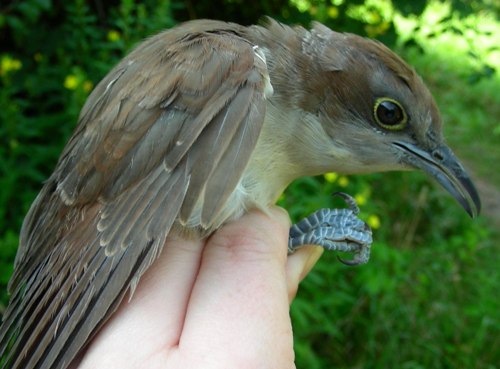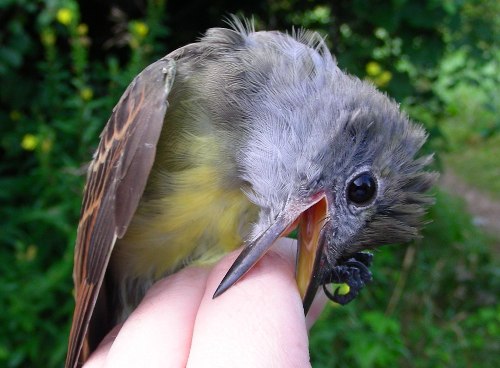|
Week 3: August 15-21, 2008 |
Welcome
to the McGill Bird Observatory weekly report.
Click here for a complete listing of our archives.
Comments or
questions are welcome at "mbo AT migrationresearch.org".
|
PICTURE
OF THE WEEK: |
|

No matter what we do, this is a species that always looks like a hunchback! This young
Black-
billed Cuckoo is only the third ever banded at MBO, and unlike the young Red-tailed
Hawk that escaped
our nets this week, we were able to get to the net in time to nab the cuckoo.
(Photo by Marie-Anne Hudson)
|
|
|
THIS WEEK |
THIS FALL |
2008 TOTAL |
SITE TOTAL |
|
# birds (and species) banded |
154 (33) |
528 (48) |
1370 (73) |
14348 (105) |
|
# birds (and species) repeat |
51 (19) |
140 (26) |
338 (38) |
2564 (63) |
|
# birds (and species) return |
-- |
11 (7) |
103 (21) |
434 (31) |
|
# species observed |
77 |
96 |
142 |
194 |
|
# net hours |
520 |
1365.8 |
4278 |
26223.8 |
|
# birds banded / 100 net hours |
29.6 |
38.7 |
32.1 |
54.7 |
|
|
Note: table does not include nocturnal banding (owls) |
|
Banders-in-charge: Marie-Anne Hudson, Barbara Frei
Assistants: Anne Chen, David Davey, Andréanne Deschamps, Simon Duval, Nicki Fleming, Gay Gruner, Alless Kockel, Dominique Lantier, Dara Mashonas, Mike Mayerhofer, Chris Murphy, Ken Nomura, Katleen Robert, Laurie St-Onge, Rodger Titman
Notes: This week was Q-U-I-E-T with warm sunny days and mostly west winds. We banded 154 birds of 33 species, which despite feeling really slow, is roughly a 50% increase from last year at this time, so we’re not complaining - this just happens to be an annual lull between the earliest migrants and the next wave to come. Even so, 11 species were spotted this week for the first time this fall: Osprey, Broad-winged Hawk, Red-tailed Hawk, Solitary Sandpiper, Olive-sided Flycatcher, Winter Wren, Ruby-crowned Kinglet, Blackburnian Warbler, Wilson’s Warbler, Scarlet Tanager, and Purple Finch, bringing our seasonal total to 96 birds. Only three species were banded for the first time this season: Black-billed Cuckoo (also new for 2008), Black-throated Blue and Wilson’s Warblers. A new species to be repeated at MBO was a young male Mourning Warbler early in the week. The high number of repeats deserves mention actually, since it illustrates how stable things have been around here lately: the birds are sticking around and hitting the nets more than once! These include Nashville, Magnolia, Wilson’s and Canada Warbler, birds we don’t often have hanging around for too long.
This week’s highlights SHOULD have included banding a young Red-tailed Hawk, but it managed to flop its way out of our nets before we were able to reach it. Real highlights include a tree full of warblers (seven species) on an otherwise uninspiring census, five species of raptors zipping by within the space of 10 minutes, the return of our little banded House Wrens in nets further away from their nest box (they’re exploring!), and banding four Great-crested Flycatchers (we’re one bird away from beating our record-high of six birds banded in the Fall of 2005).
This week’s top 10 banded species contains half of last week’s species, most notably the top spot: American Redstarts are still holding down the fort. The five new species are all warblers: Magnolia, Chestnut-sided, Common Yellowthroat, Yellow and Nashville, resulting in just two species on our list that are not warblers! The Canada Warbler merits particular mention, as the total of 19 over the past two weeks already eclipses our previous high for any entire fall season. The numbers are especially encouraging given that the species was newly listed as Threatened by COSEWIC this past April, based on significant long-term declines across its breeding range.
This week’s
top 10
[last week’s rank in brackets]
#
individuals banded |
mean # individuals observed daily |
1. American Redstart (22) [1] |
1.
American Crow (20) [2] |
2.
Magnolia Warbler (12) [-] |
2.
Common Grackle (19) [1] |
3.
Chestnut-sided Warbler (10) [-] |
3.
Black-capped Chickadee (16) [3] |
3.
Song Sparrow (10) [4] |
4. American Goldfinch (15) [3] |
5.
Baltimore Oriole (9) [2] |
5. American Robin (13) [7] |
5.
Canada Warbler (9) [6] |
6.
Cedar Waxwing (12) [5] |
5.
Common Yellowthroat (9) [-] |
7. Blue Jay (8) [6] |
8. Ovenbird (7) [8] |
8.
Song Sparrow (7) [8] |
8. Yellow Warbler (7) [-] |
9. Ruby-throated Hummingbird (6) [-] |
10. Nashville Warbler (6) [-] |
9.
Common Yellowthroat (6) [-] |
|
Only two new species made it on to the top 10 observed list this week, and all the way at the bottom of the pile. The top eight have simply been reshuffled, again indicating the relative stability of the community around MBO this past week. Though we’ve enjoyed the slow pace this week which makes for some easy banding, we’re certainly looking forward to the cooler, bird-filled mornings of September and especially October! Now is the time for new and old volunteers alike to brush up on the skills that will help us get through that busy period with quick and safe handling of all birds. There are still openings for volunteers on most mornings for the rest of the season, but we know from past experience the days will begin to fill up - reserve your preferences now if you can!
|

These guys always have something to say (or bite) when we need to take a photo. This Great-crested Flycatcher was no exception.
(Photo by Marie-Anne Hudson)
|


